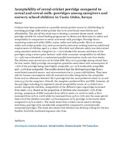| dc.contributor.author | Kinyuru, John | |
| dc.contributor.author | Kipkoech, Carolyne | |
| dc.contributor.author | Imathiu, Samuel | |
| dc.contributor.author | Konyole, Silvenus | |
| dc.contributor.author | Roos, Nanna | |
| dc.date.accessioned | 2022-01-10T09:38:02Z | |
| dc.date.available | 2022-01-10T09:38:02Z | |
| dc.date.issued | 2021-01-07 | |
| dc.identifier.govdoc | https://link.springer.com/article/10.1007%2Fs42690-020-00388-1 | |
| dc.identifier.uri | https://doi.org/10.1007/s42690-020-00388-1 | |
| dc.identifier.uri | http://ir-library.mmust.ac.ke:8080/xmlui/handle/123456789/2004 | |
| dc.description.abstract | Crickets have been promoted as a possible animal protein source in child feeding by enriching porridge with cricket powder due to its nutritional contribution and affordability. The aim of this study was to develop a nutrient-dense cereal- cricket porridge suitable for school feeding programmes in Kenya and determine its safety and acceptability in comparison to cereal and cereal-milk porridges. Porridge flours containing maize and millet (MM), maize, millet and milk powder (M10) or maize, millet and cricket powder (C5) were processed by extrusion cooking based on nutritional requirements of children aged 3–5 years. Microbial and aflatoxin safety was determined using standard methods. Caregivers (n = 73) evaluated the sensory attributes of the porridges using a seven-point hedonic scale while consumer acceptability by children (n = 138) was evaluated in a randomized parallel intervention study over four weeks. The children were served 300 ml of either MM, M10 or C5 porridge during school days for four weeks. Daily porridge consumption quantities were taken with consumption of >75% of the porridge being rated highly acceptable, 50–75% moderately acceptable and < 50% least acceptable. The results showed that the developed porridge flours contributed essential macro- and micronutrients for 3–5 years old children. They were safe for human consumption with all assessed microbes being below the acceptable limits and no aflatoxins detected. M10 porridge had the most preferred colour (6.4) and taste (5.5) by the caregivers. Overall, the caregivers preferred M10 and MM, however, all the porridges including C5 registered overall acceptability scores of ≥5 (Liked very much). Among the children, acceptability of the different types of porridge increased from week 1 to 4. Based on the proportion of children who consumed >75% of the serving, acceptance of MM increased from 98% in week 1 to 100% in week 4, M10 increased from 91% to 100% while C5 increased from 55% to 70% over the same period. Only 5% of the children recorded <50% acceptance of C5 porridge in the fourth week compared to 15% at week 1. The study shows that crickets can be used to develop nutritious, porridge with considerable acceptability compared to conventionally consumed porridges. The study also shows that children can develop a liking for the less familiar food with continued exposure over time. | en_US |
| dc.language.iso | en | en_US |
| dc.publisher | International Journal of Tropical Insect Science | en_US |
| dc.subject | Acceptability, cereal-cricket, porridge, compared, cereal, cereal-milk- porridges, caregivers, nursery ,school, children | en_US |
| dc.title | Acceptability of cereal-cricket porridge compared to cereal and cereal-milk- porridges among caregivers and nursery school children in Uasin Gishu, Kenya | en_US |
| dc.type | Article | en_US |

